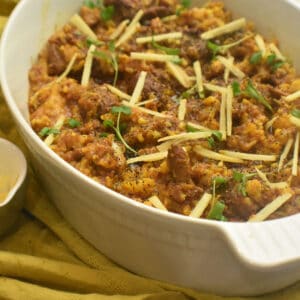Cauliflower, known as “Gobi” in my native language is a popular winter vegetable in Pakistan. Although it’s available year around here in the USA, the cold weather has me craving it more. Memories of eating aloo gobi, gobi keema and of course gobi gosht in the cold winter months is pure nostalgia. This Gobi Gosht recipe is inspired by my sarson-ka-saag-mustard-greens recipe, another favorite winter classic. Although this is delicious enough to eat on it’s own, it pairs beautifully with this raita-recipe-for-biryani.
Ingredients
As always, I like to use mainly simple fresh ingredients coupled with a few basic spices in my Pakistani Recipes. Certain slow cooked traditional recipes call for more complex spices, but most day to day Pakistani Cooking consists of easy recipes.
Cooking Oil - I always like to use avocado oil for my curries. It has a high smoke point so it’s perfect for curries.Beef - This curry is traditionally made with bone-in goat meat, but since my kids prefer boneless meat I’ve reverted to making it with beef. Cauliflower - When picking your cauliflower, make sure it’s pale in color, with no soft or sunburned spots. Onion - I like to use yellow onions for their neutral taste.Garlic Paste - I prefer to make my own paste from fresh garlic cloves and freeze it. But store bought paste is also an option and saves considerable time. Although some people like to use ginger garlic paste, I prefer to add the ginger in separately later.Tomatoes -Medium tomatoes, usually Roma’s, are best for curries due to their juicy and plump texture.Salt - My go to is coarse kosher salt but once again, you can go with whatever variety you prefer.Coriander - I always like to add coriander powder to my curries. Besides the earthy smell and nutty taste, it adds a beautiful brown color to the meat during the roasting process.Turmeric - I have yet to cook a curry without this warm and fragrant spice. Remember to add only a small amount of turmeric powder though, as too much can make the curry taste bitter.Red Chili Powder - The backbone of all Pakistani curries, this gives all the spice and red vibrant color we associate with a curry! Peppercorns - These add a nice peppery smell when roasting the meat but make sure not to bite into them when eating your curry! Ginger - The ginger is what really takes this recipe to the top! Cauliflower is very bland on it’s own so it needs that extra flavor. This is why I like to add it at the end, so it retains its peppery taste.
Instructions
The video and steps detailed below will help you as you cook the Gobi gosht so that you get perfect results the first time round!
Sauteing the onions is always the most important step in any curry. They have to be a nice rich brown color in order to create the perfect base. The texture and flavor of the curry depends on it. Heat oil and sauté onions first. Then add the garlic and saute for about 30 seconds before you brown the meat to seal in all the juices. Finally, add the tomatoes and just enough water to cover the meat. Cook this mixture on medium heat till the meat is almost tender. Once the meat is almost cooked through, dry all the excess liquid by turning the stove on high heat. Then add in all the powdered spices and roast the meat. This simple step roasts the spices and also breaks down the onions and tomatoes to help insure a smooth curry.As the last step, add in the cauliflower, peppercorn and ginger along with a cup of water. The water helps create steam which finishes cooking the meat and the cauliflower. Cover the pot and simmer the mixture over a medium flame till the cauliflower is cooked through. Then turn the flame on high and dry all the excess liquid, about 2-3 minutes or more depending on your stove.Garnish the Gobi Gosht with ginger and cilantro (fresh coriander) and serve with fresh hot Naan or bread of your choice!
If you’re like my husband you’ll add a sprinkling of black pepper on top as well! The spicier the better!
Variations
Here are some alternatives for the meat and spices so you can customize this recipe a bit more to suit your personal taste!
Meat - Another good boneless option is lamb meat. The shoulder cut is very juicy when cooked and any butcher will cut it for you. I prefer beef as it’s less fatty, but if you find it too tough and stringy and lamb too fatty, you can also opt for veal.Spices - If you like your food less spicy you can use half red chili powder and half Kashmiri chili powder. If you can’t source Kashmiri chili powder, Paprika is a great substitute.
Storage
The Gobi Gosht can stay in the fridge for 2-3 days and in the freezer for upto 3 months. To reheat, just defrost and microwave! Please don’t forget to leave a rating and comment below! If you take a picture then please tag me on instagram ! Thank You! In layman’s terms and as per thekitchn.com what this means is that the surface of the meat caramelizes, resulting in a more complex “meat” flavor. This will elevate your entree’ from flat and boring to something that will have people talking about it for days!




